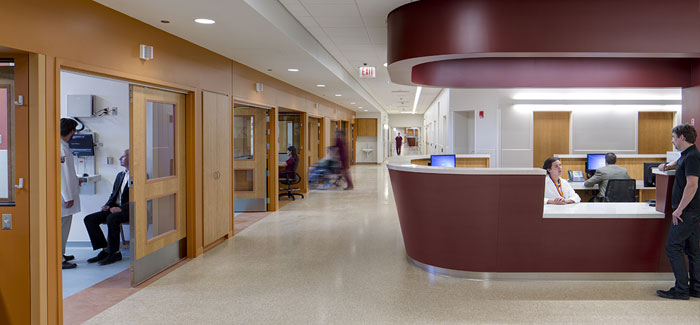
An ambitious attempt to drive biomedical research and patient care, the University’s $700-million new hospital opened February 23. (Photography by Tom Rossiter)
Technology extends the reach of the University's new hospital.
Rising ten stories, the Center for Care and Discovery projects a high profile on campus in more ways than one. The University’s new hospital, which opened February 23, represents an ambitious attempt to drive biomedical research and improve patient care.
The $700 million, 1.2-million-square-foot building is one of the largest structures on Chicago’s South Side. There are 240 single-occupancy patient rooms with space for families to stay overnight. There are plans to expand from the initial 17 operating rooms to 24, and the building can accommodate as many as 28. Some of the surgical facilities will be “robot rooms” that allow two surgeons to work simultaneously.
“With the Center for Care and Discovery, we have a living laboratory that will transform how we care for patients, using leading-edge technology and innovative research to deliver advanced clinical treatments,” says Sharon O’Keefe, president of the University of Chicago Medical Center.
The new hospital’s design, size, and proximity to campus research facilities are well suited for collaboration, and telemedicine will push this collaborative environment beyond its own walls and beyond Chicago. While the technology isn’t new—witness Skype and FaceTime—the seamless communication among physicians, researchers, medical students, and patient families will improve care and facilitate innovation.
The hospital’s large hybrid operating rooms allow teams of surgeons, nurses, and other medical specialists from multiple disciplines to work side by side. The building’s location near the Gordon Center for Integrative Science and the Knapp Center for Biomedical Discovery puts physicians in close contact with researchers in the biological and basic sciences, streamlining the translation of discoveries into treatments.
The hospital’s telecommunications technology can broadcast images and live video of procedures securely online. Physicians will use it to communicate with technicians elsewhere on campus, train medical students in remote classrooms, and consult with specialists anywhere in the world.
The system can integrate with the hospital’s IT infrastructure and imaging systems, such as those used by radiologists and pathologists, combining the examining room and the work of a diagnostic lab. For example, D. Kyle Hogarth, assistant professor of medicine and director of bronchoscopy and minimally invasive diagnostics, can now use a microscope-mounted bronchoscope. Inserted through a patient’s mouth into the lungs, the device looks for cancerous growths in areas that previously required invasive measures to reach.
“We actually now have the ability, literally, to have a live microscope on the end of our scope,” Hogarth says. “You’ll see microscopic images as if you had your microscope on the bench, looking under it, except it’s live, it’s real, it’s right there.”
These images can be transmitted so experts at other facilities can watch procedures as they happen and provide feedback. The system can also record and broadcast video to the hospital’s conference center and patient consultation rooms, enabling physicians to review procedures with colleagues, medical students, and patient families.
The new level of connectivity not only improves collaboration with fellow surgeons and students, says Arieh Shalhav, professor of surgery and director of minimally invasive urology, but also improves patient care. “The teaching is better, the clinical service is better, and development of new procedures, new ideas, and new concepts is much more readily available than it was before.”
